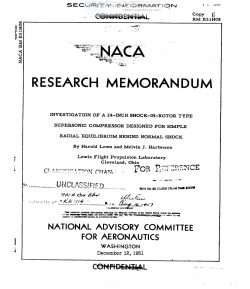naca-rm-e51h08
- Version
- 47 Downloads
- 1.07 MB File Size
- 1 File Count
- May 25, 2017 Create Date
- May 25, 2017 Last Updated
National Advisory Committee for Aeronautics, Research Memorandum - Investigation of a 24-Inch Shock-In-Rotor Type Supersonic Compressor Designed for Simple Radial Equilibrium Behind Normal Shock

The design of a 24—inch—diameter supersonic-compressor rotor based
on the establishment of simple radial equilibrium.behind the normal
shock and a controlled diffusion rate was-investigated in Freon—12.
Inlet guide vanes were used as a means of establishing the theoretically
required entrance conditions. This design followed from a previous
investigation of a 24—inch—diameter supersonic-compressor rotor.
A maximum total-pressure ratio of 2.02 at an adiabatic efficiency
of 0.74 and a weight flow of 61.5 pounds per second were obtained at an
equivalent tip speed of 1590 feet per second, with supersonic flow
existing over the entire passage height. The investigation further
revealed that although the radial accelerations behind the shock were
theoretically reduced over most of the passage, this reduction had no
apparent effect on the radial redistribution of mass flow. The shock
boundary—layer interaction.pattern and associated effects must be con-
sidered along with the theoretically computed radial forces.
The shock—inrrotor type supersonic compressor offers a serious
problem in subsonic diffusion because of the shock boundary—layer inter-
action. This problem, in addition to the considerations of radial
forces, must be solved before good stage performance can.be realized for
this type of compressor.
An analytical study of supersonic axial-flow compressor performance
(reference 1) has indicated that stage pressure ratios of around 5 are
feasible for the shock-in-rotor type supersonic compressor. In order to
obtain the desired pressure ratio for this type of rotor, however, dif-
fusion of the relative Mach number at the blade exit to 0.60 or below
is required. Failure to obtain this diffusion presents one of the ser-
ious limitations on the performance of the shock-in-rotor type supersonic
compressor.
| File | Action |
|---|---|
| naca-rm-e51h08 Investigation of a 24-Inch Shock-In-Rotor Type Supersonic Compressor Designed for Simple Radial Equilibrium Behind Normal Shock.pdf | Download |

Comment On This Post